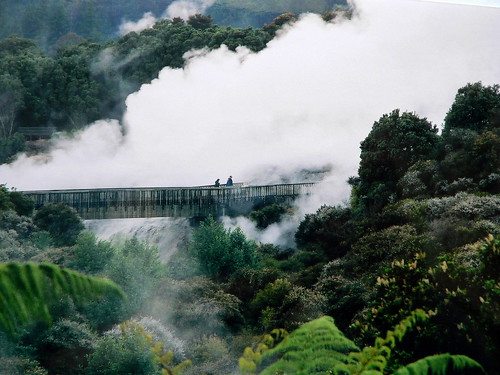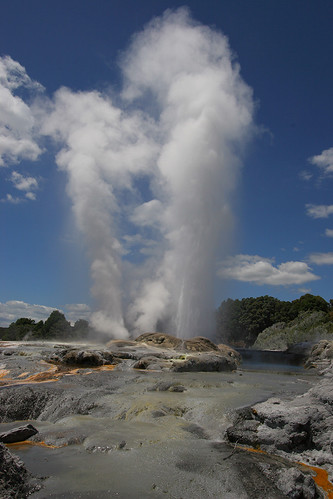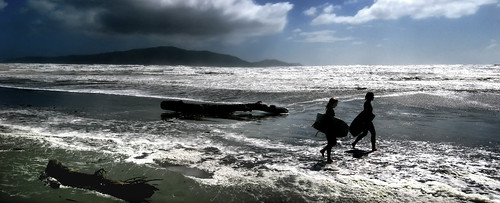
Speaking of this geographic area us back to history, as they were one of the last places on earth to be inhabited. The Maori came to these remote islands about seven centuries ago and the Europeans just three hundred years ago.
It may be the last corner of the planet, but before the film director Peter Jackson did the best promotion of tourism in the archipelago of the Ring trilogy, New Zealand and could boast of having a centennial tourism department. Despite the remoteness, the Kiwis (the name by which New Zealanders call themselves) had always clear the intense appeal of their lands, of the least densely populated in the world and its varied and spectacular scenery.
This archipelago located about 1600 km southeast of Australia is composed of two major islands, North Island and South Island, and a set of smaller islands. The population is very low, barely 4 million for an area somewhat larger than that of Britain, most of which live in the cities of the North Island, the original Aotearoa, the name given by the Polynesian navigator Kupe when he reached the islands, in 950 AD, by the way they elongated cloud.
Each island has its own unique geographical and geological, and if the northern part is volcanic, with plateaus, geysers and spectacular white sand beaches, the south is almost entirely crossed by a ridge known as the Southern Alps, with more 20 mountains over 3,000 meters, and in dry arid territory, almost deserted, are fjords and glaciers of striking beauty.
Few countries in the world offer both a territory as small, compact, varied and easy to navigate alone. This country is available both for those who come seeking peace and solitude and for those adrenaline is an indispensable part of your holiday.
While many visitors who take the most popular way to travel between the very local: the campers, the backpack or car rental for exploring on their own account, a long but narrow country road with little traffic. There is accommodation to suit all tastes and pockets, and the possibility of staying on farms where the daily share with the locals, and countless agencies that book excursions to reach those places where access is more complicated.
Nature and culture:
In an area of 1600 km long and where there is barely 200 km from coast to coast across the South Island, the possibilities are endless white sand beaches and waves for surfing, creeks, parks, active and inactive volcanoes , caves, mountains, glaciers, fjords, lakes, islands newborn small but cosmopolitan cities, sports of all kinds, Maori culture and Pakeha (the descendants of British settlers) … all in one place for its location and history, just has transformed its original nature.

The 15 percent of the population were Maori, whose language shares official status with English, and their traditions and customs can be seen in places such as Rotorua, the heart of the North Island, an area of high thermal activity in which city can visit the cultural center Te Whakarewarewa. There Haka representations are made, the renowned warrior dance and song selection that the New Zealand Maori rugby has become famous in their International.

Wellington:
New Zealand is actually a huge nature reserve, since in its territory there are twenty national parks, twenty-three maritime forest. Two of the parks were declared World Heritage by UNESCO: Tongariro National Park in the North Island, and the national park you Waihipouna in the South Island. The difficulty lies in choosing the traveler to do in the time of his trip. Our recommendation to make better travel day is always one-way from north to south or vice versa, the excursions booked in advance and ask for weather conditions, since in the austral winter, some activities are canceled due to bad weather.

A tour of the North Island should not exclude the visit to the Auckland region, where the largest city in New Zealand and Karekare Beach, where he filmed scenes from the film The Piano, as well as the forests of kauri tree in Waipoua. Do not miss, either, the Bay of Islands, with more than 140 islets, the Rotorua thermal area and the impressive underground caves of Waitomo, the White Island, one of the most impressive active volcanoes in the country, the Tongariro National Park , with trips of various difficulties and the possibility of skiing in winter. And if time permits, Eastland, New Zealand’s last frontier, Maori land, or the Coromandel Peninsula, two little-known places for tourists.
Queenstown, the world capital of extreme sports:
And if the North Island is amazing with its beaches, volcanoes and fumaroles, this part just remember what we left behind. We start our tour in Picton, and continue to Kaikoura, where the main attraction is the whale and sperm whales. Slightly further south is the city of Christchurch English influence, and follow the path of achieving Dunedim coast a few miles of which are in the nature reserve of the Otago Peninsula.
West of the island is Fiordland Park, with 14 spectacular fjords to visit by sea, land or air, whose best known part is Milford Sounds. From here we can move to Queenstown and spend a few days if you enjoy adventure sports. Further north are Mount Cook, the highest peak in the Southern Alps, and glaciers, as the popular Fox and Franz Josef.

The realm of adventure They call it the world capital of extreme sports. Queenstown, a picturesque and lively town of South Island, on the shores of Lake Wakatipu and close to the mountains The Remarkables. Perhaps this combination of factors in this county and surrounding areas giving a high concentration of different adventure sports on the planet. Anything that is able to raise the adrenaline can do here: hang gliding, parachuting alone or in tandem, paragliding, bungee jumping (which here is called bungee jumping), rafting, snowboarding, rock climbing, mountains or buildings , abseiling, canoeing, kayaking, etc..
Despite the infinite variety of sports to choose from, the true king of the islands remains Tramping, as it is called here the trails. In New Zealand there are ways for everyone, both for those who enjoy quiet roads and paths to those who demand more intricate, in any region of the country, especially in national parks and natural, but also outside them. The opinion of travelers is unanimous: the Milford Track in Fiordland, is the world’s most beautiful route.
Surfing in ranglan:
Water sports:
With 15,800 miles of coastline, plus a significant number of lakes and rivers, it is not surprising that you can practice all kinds of watersports, from sailing in any vessel including motorcycle or water sled, to more risky hydrosliding as the boarding boogei, skydiving or river rafting. Some love the sea must have when in Auckland Kiwis boast the same number of boats that people in the city.

For surfers, in rangle, about 50 km from the town of Hamilton in the North Island, connoisseurs say that there are three of the best places in the world where the waves left open. Fishing enthusiasts have the opportunity here to get a piece record in any of its rivers and lakes, such as Rotoura or Taipo, and those who prefer to see fish without catching them, Jacques Cousteau said that the subject was the Poor Knights Islands one of the best places in the world for scuba diving.
A fantastic tour in New Zealand!.
Leave a Reply
You must be logged in to post a comment.
Recent Comments